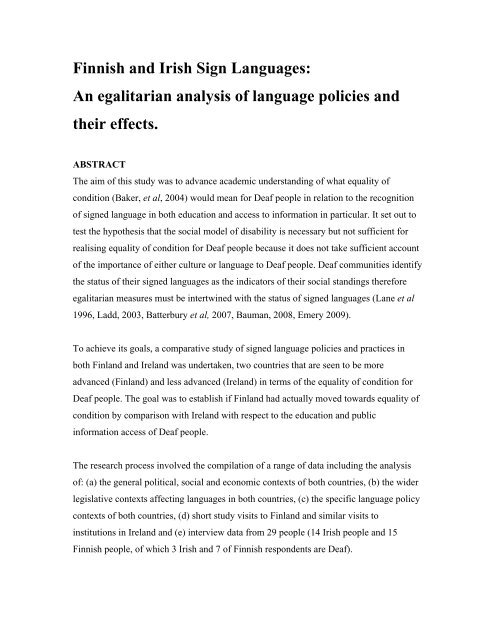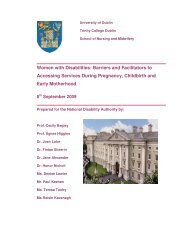Finnish and Irish Sign Languages: An egalitarian analysis of ...
Finnish and Irish Sign Languages: An egalitarian analysis of ...
Finnish and Irish Sign Languages: An egalitarian analysis of ...
- No tags were found...
You also want an ePaper? Increase the reach of your titles
YUMPU automatically turns print PDFs into web optimized ePapers that Google loves.
<strong>Finnish</strong> <strong>and</strong> <strong>Irish</strong> <strong>Sign</strong> <strong>Languages</strong>:<strong>An</strong> <strong>egalitarian</strong> <strong>analysis</strong> <strong>of</strong> language policies <strong>and</strong>their effects.ABSTRACTThe aim <strong>of</strong> this study was to advance academic underst<strong>and</strong>ing <strong>of</strong> what equality <strong>of</strong>condition (Baker, et al, 2004) would mean for Deaf people in relation to the recognition<strong>of</strong> signed language in both education <strong>and</strong> access to information in particular. It set out totest the hypothesis that the social model <strong>of</strong> disability is necessary but not sufficient forrealising equality <strong>of</strong> condition for Deaf people because it does not take sufficient account<strong>of</strong> the importance <strong>of</strong> either culture or language to Deaf people. Deaf communities identifythe status <strong>of</strong> their signed languages as the indicators <strong>of</strong> their social st<strong>and</strong>ings therefore<strong>egalitarian</strong> measures must be intertwined with the status <strong>of</strong> signed languages (Lane et al1996, Ladd, 2003, Batterbury et al, 2007, Bauman, 2008, Emery 2009).To achieve its goals, a comparative study <strong>of</strong> signed language policies <strong>and</strong> practices inboth Finl<strong>and</strong> <strong>and</strong> Irel<strong>and</strong> was undertaken, two countries that are seen to be moreadvanced (Finl<strong>and</strong>) <strong>and</strong> less advanced (Irel<strong>and</strong>) in terms <strong>of</strong> the equality <strong>of</strong> condition forDeaf people. The goal was to establish if Finl<strong>and</strong> had actually moved towards equality <strong>of</strong>condition by comparison with Irel<strong>and</strong> with respect to the education <strong>and</strong> publicinformation access <strong>of</strong> Deaf people.The research process involved the compilation <strong>of</strong> a range <strong>of</strong> data including the <strong>analysis</strong><strong>of</strong>: (a) the general political, social <strong>and</strong> economic contexts <strong>of</strong> both countries, (b) the widerlegislative contexts affecting languages in both countries, (c) the specific language policycontexts <strong>of</strong> both countries, (d) short study visits to Finl<strong>and</strong> <strong>and</strong> similar visits toinstitutions in Irel<strong>and</strong> <strong>and</strong> (e) interview data from 29 people (14 <strong>Irish</strong> people <strong>and</strong> 15<strong>Finnish</strong> people, <strong>of</strong> which 3 <strong>Irish</strong> <strong>and</strong> 7 <strong>of</strong> <strong>Finnish</strong> respondents are Deaf).
















